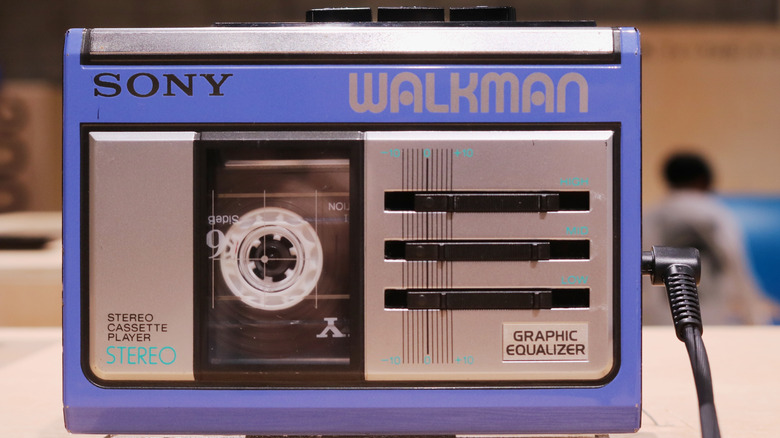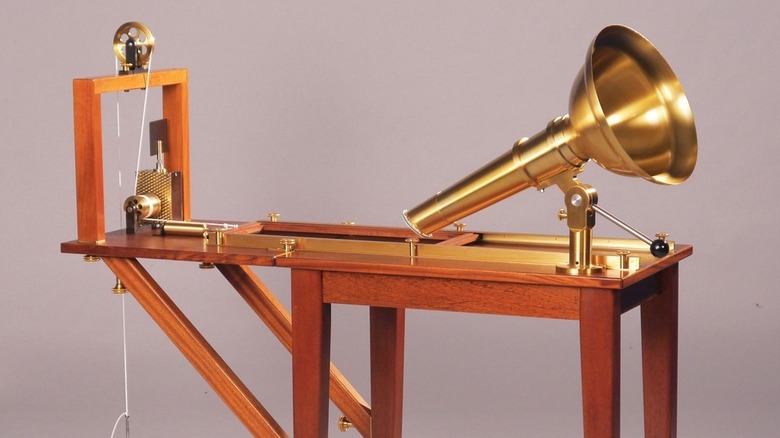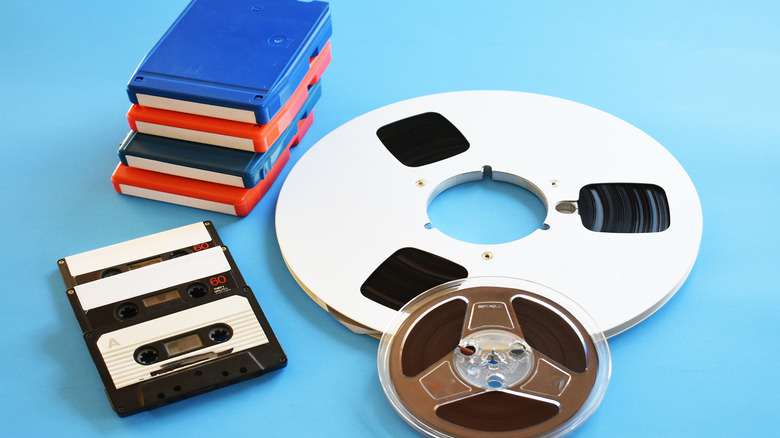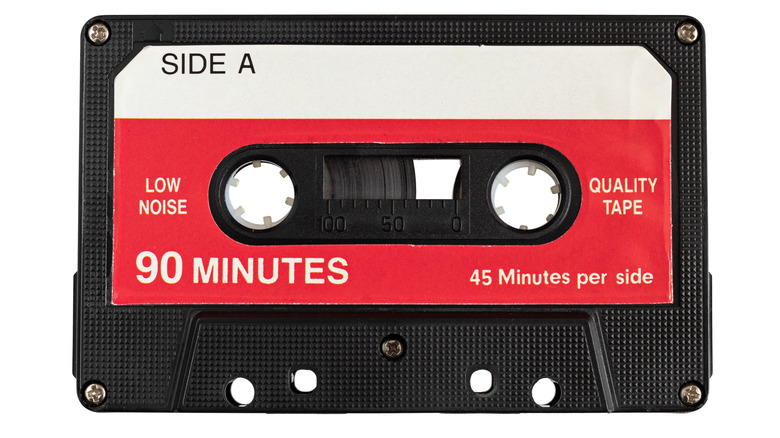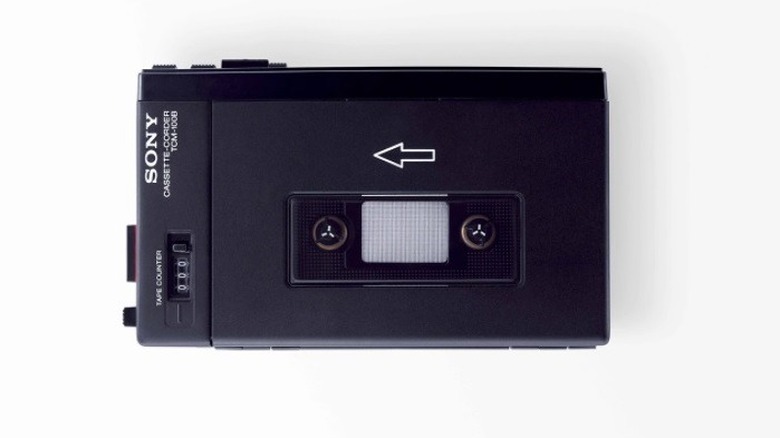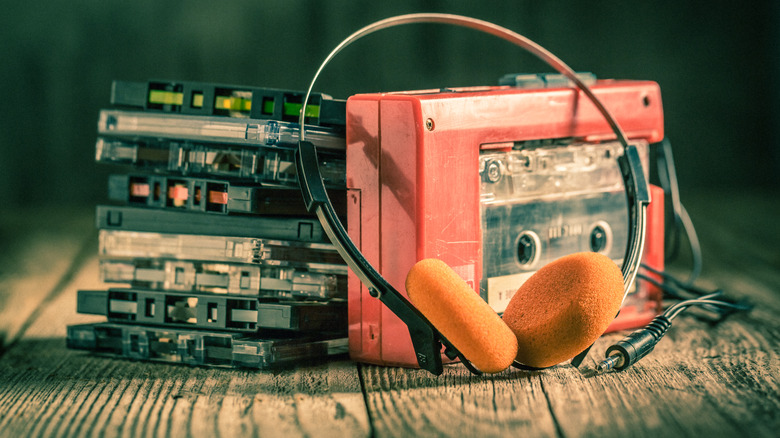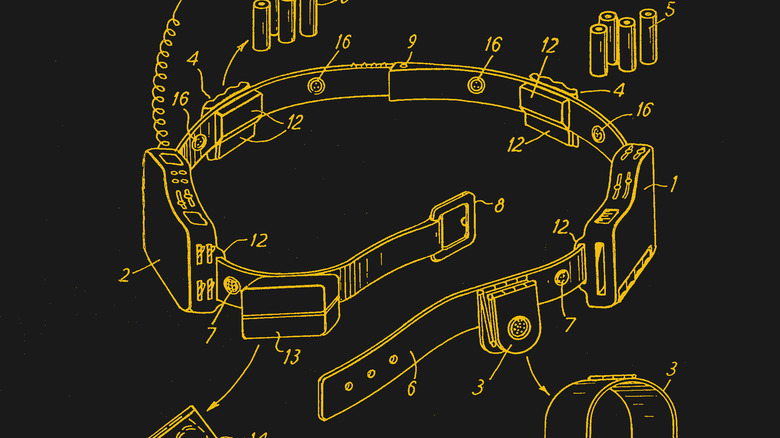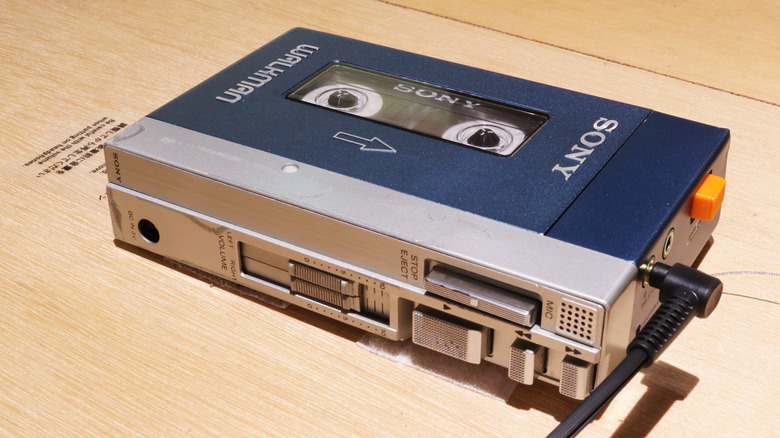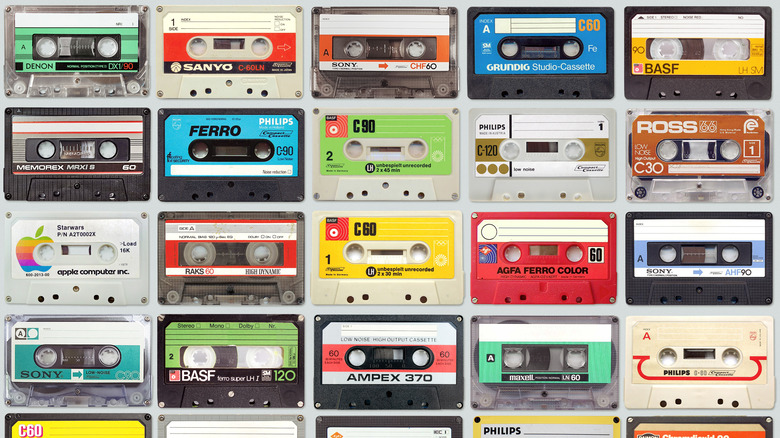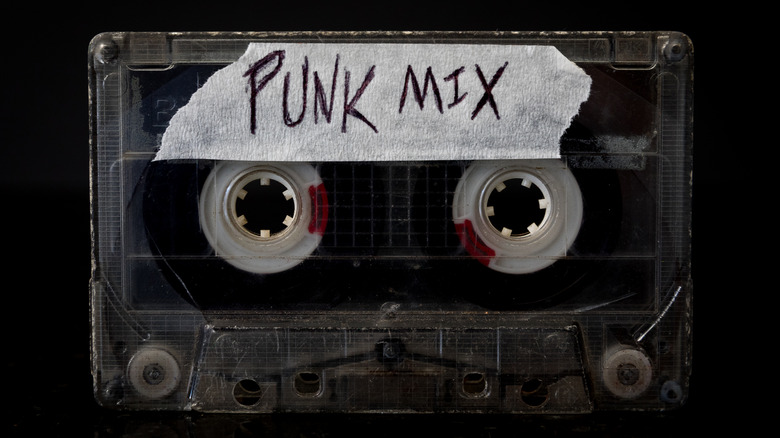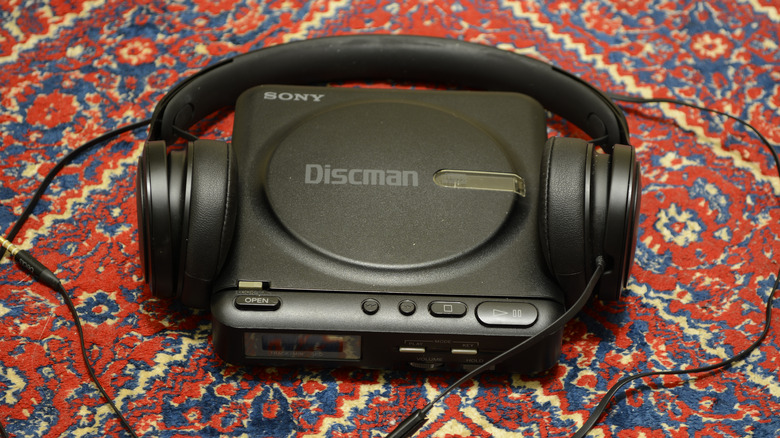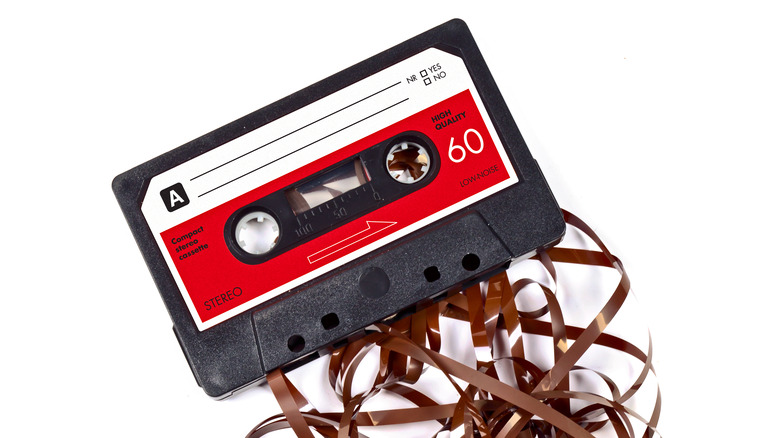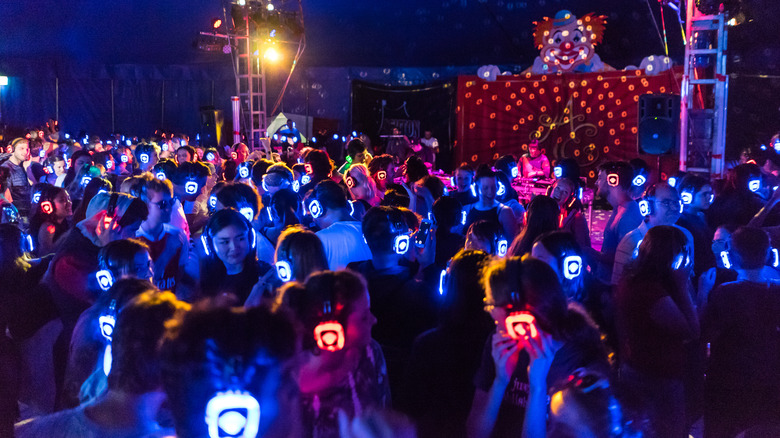The Fascinating History Of The Walkman
It's almost hard to imagine life before headphones and customized playlists, a time when you couldn't take your favorite tunes with you no matter where you were going or what you were doing. That was the case, however, for every single person who lived out their lives prior to the late 1970s.
Before then, music was a destination activity. In the distant past it was something you either had to make yourself or else listen to live, in person, and perhaps never hear again. Later, music began being recorded but was still tethered to a destination. In order to listen you had to be in the car, at a venue, or near bulky audio equipment at home. Listening to music was necessarily communal. People had to agree on what to listen to and kids everywhere had no choice but to scoff at the dated musical tastes of their parents.
The invention of the Sony Walkman in 1979 changed all that (via Design Museum). By combining a couple of existing technologies in a novel way, people could take their music with them wherever they went and listen to it privately for the first time in history.
The Walkman's reign over the music industry is long since over, but its impact on popular culture remains both in the way it symbolizes an era and in the impact it had on modern society.
The earliest known recorded sounds
The Walkman couldn't exist at all without the prior invention of recorded music. So, in order to properly tell its story, we have to go back to the middle of the 19th century. Thomas Edison is often credited as the father of recorded sound, made possible by the phonograph which was invented in 1877.
Historians discovered in 2007, however, that Edison was beat to the punch roughly twenty years earlier by French inventor Edouard-Leon Scott. In 1857, Scott delivered a number of paper recordings to the French patent office, created with what he called a "phonautograph."
The key difference between Scott and Edison was that Scott had no real intention of the sounds being played back. Instead, he imagined a world in which people learned to read soundwaves on paper like you would a written language, taking in all the relevant auditory information. Scott's invention worked in a similar fashion to the phonograph by taking in sounds and translating the vibrations to a physical medium. They didn't catch on, though, probably because even modern audio engineers struggle to recognize audio waveforms.
Luckily, Scott got a happy ending when the recordings were rediscovered and, using modern technology, played back for the first time. Those recordings are now stored as a part of the First Sounds project.
The evolution of recorded music
After the invention of Edison's phonograph and its release to the general public, the technology would be improved upon in coming years, both by Edison and by others, transitioning from the original tinfoil recording to the use of wax cylinders. In the 1880s, Emile Berliner made a further improvement with the introduction of the flat record (via Library of Congress). These first records were made of glass and later zinc. Being sturdier than the wax cylinders, they allowed for a more permanent recording and eventually, for mass production.
Records remained the primary way to consume recorded audio for nearly a century with few competitors. In 1964, William Lear invented the 8-track tape which has enjoyed a longer life than in the popular memory than it ever did in reality (via National Museum of American History). Their brief popularity was driven in large part by a deal with the Ford Motor Company which installed them standard in new cars.
Car stereos had existed since the 1930s and Chrysler made a short-lived attempt at the first recorded audio stereo in a car with their onboard turntable in the '50s. Despite reportedly working well, the technology didn't really catch on in cars the way 8-track players did.
By this time, however, audio technology was out of its infancy and rapidly evolving. The days of the 8-track were numbered.
The invention of the cassette tape
Magnetic recording, using steel wire, first emerged at the turn of the 20th century but it took nearly four decades to make the switch to magnetic tape. The new format greatly improved audio output quality but the technology was bulky. Not the sort of thing you could easily cart around with you. By 1958, RCA had released a cassette tape that was smaller than the prior reel-to-reel technology, while still being prohibitively large. They were roughly three times the size of the cassette tape we know and love, about the same size as a videocassette.
In the 1960s Lou Otten, who was working for Philips at the time, set out to shrink the technology into something which could fit inside a pocket. A few years later he pulled it off, and the familiar cassette tape was born. By 1966, albums were being recorded on cassette and by the '70s, cassette players had made their way into cars, quickly supplanting the previously popular 8-track player.
The Sony Pressman took audio recording on the go
The introduction of the cassette tape made audio recording more portable and, in addition to mass-produced albums, early applications centered on personal recording. With that in mind, Sony released the TC-100 in 1966. It was about the size of an old answering machine, Radio Museum notes, too large to comfortably carry around but perfect for setting on a table or desk.
Two years later a new model, the TC-50, was small enough to fit in one hand and had a built-in microphone. NASA sent this model into space astronauts during the Apollo missions to more easily record their activities.
Handheld cassette recording devices really hit their stride ten years later when Sony released the Pressman, an improved recorder with a sleeker design commonly used by reporters and businesspeople. It was so well received that Sony noted it had produced more than half a million units, a pretty impressive milestone for what was essentially a niche item at the time.
Looking at the Pressman is like seeing the most recent ancestor of a species right before it emerges. So nearly there but missing one or two essential components. By the time the Pressman hit the scene, the Walkman was inevitable.
The Walkman, the solution to a personal yet universal problem
By the late '70s, music on demand had become a permanent part of popular culture. People were able to easily get recordings of their favorite artists to play at home or while driving and moderately portable boomboxes — massive by today's standards — let people take their music into the world.
Yet music still hadn't invaded every corner of our lives. There were certain situations in which it might not have been polite to crank up your boombox, and the size was still prohibitive. A personal cassette player with included headphones was primed for creation.
The story goes that in 1979, shortly after the release of the Pressman, Sony's chairman Masaru Ibuka asked an employee, Norio Ohga, if he could create a device that would allow Ibuka to listen to tapes while on international flights.
Using the Pressman as the foundation, Ohga made a prototype device in time for Ibuka's next flight. Ibuka was so impressed that the device went into production before the end of the year. Sony called the gadget a Walkman, a portmanteau of Pressman that made the newfound ability to privately listen to music while walking around a possibility.
Andreas Pavel, the Walkman's real inventor?
In 1977, Andreas Pavel registered patents for a device he called the Stereobelt, according to Google Patents. The name refers to the ability of a user to wear the gadget attached to their body. When the Walkman hit the market, Pavel initiated negotiations with Sony for royalties. The company initially agreed to pay royalties only on units sold in Germany but Pavel persisted, continuing litigation for nearly 25 years, insisting that he was the rightful inventor of the Walkman.
While Sony continually maintained they were the rightful creators and rejected Pavel's origination claim, the company did resume negotiations with Pavel in 2001. Those conversations ultimately resulted in an out-of-court settlement for an undisclosed amount in exchange for the cessation of any further litigation (via CNET).
It's unclear if Sony was ever aware of Pavel's patents, and the technological landscape was certainly primed for the emergence of such a device regardless. However, according to sources close to the case, Sony paid Pavel the equivalent of several million dollars. The settlement means that Sony will likely retain the historical honor of having invented the Walkman. Pavel being unable to claim ownership of his invention probably hurts his ego, but that's probably easier to swallow when you have millions of dollars to show for it.
Launch of the Walkman TPS-L2
The first Walkman, the TPS-L2, hit the Japanese market in late 1979 with a measured rollout. While Sony was confident they had a good idea on their hands, they weren't sure how the public would respond. The original manufacturing run was only for 30,000 units. Sony initially predicted that number should last them half a year, selling an estimated 5,000 every month. That initial caution proved to be warranted as the first month of sales was slow. The youth of Japan, however, quickly became enamored with their new toy and sales skyrocketed. By the time the Walkman was 60 days old, the company had sold 50,000 units.
The Walkman came to the United States in the middle of 1980 under the name Soundabout. Sony eventually decided they didn't want to market under a different name in each country and the Walkman moniker became ubiquitous. The technology of the time would be considered chunky when compared with what we're used to today. The sound quality wasn't great, the device was still larger than Sony wanted, and the headphones were bulky. Despite those challenges, the Walkman proved to be a defining feature of the 1980s.
The Walkman quickly became a runaway hit
After a lackluster first month of sales, the Walkman hit its stride. Originally priced at $200, an equivalent of $700 in today's money, proved to not be too expensive for consumers. It quickly became a status symbol for the technologically savvy around the world. Once the public caught on to what the Walkman offered, Sony quickly sold out of their initial run of 30,000 and had to ramp up production. As a result, the demand for personal music on the go significantly outpaced the supply, and consumers were placed on waitlists at outlets around the country.
The public demand for the Walkman was so substantial and the way it changed the culture of music by putting headphones on the head of the public so influential was so substantial that academics were asking if we had made an irrevocable mistake that might forever ruin the way we communicate with one another, or don't.
That initial run of 50,000 was only a hint of what was to come. Over the coming years, the Walkman became a mainstay of popular culture, defining not only the way we consumed music but how we interact with the world around us. By the end of its run, the Walkman would sell more than 200 million units.
The Walkman's impact on the music industry
For most of the previous century, records had a stranglehold on music production and album sales (via The Vinyl Revivers). The 8-track had come and gone in a blip without making much of a dent in the record's dominion. The emergence of the cassette tape put the format on the map, and it was slowly growing, driven largely by the introduction of tape decks in cars. The emergence of the Walkman would push the cassette into overdrive.
By 1983, only a few years after the Walkman hit the scene, sales of cassette tapes overshadowed those of records for the first time in history. The introduction of compact discs (CDs) started chipping away at that lead two years later, in 1985, but cassettes remained the dominant form of audio media through 1990, largely as a result of the Walkman's popularity.
Even after the popularity of the cassette began to wane in the '90s, sales of the Walkman remained strong throughout the rest of the decade, with more than 100 million units shipped.
Heyday! Mixtapes and personal identity through soundtrack
Mixtapes existed prior to the invention of the Walkman, made popular by early hip-hop artists and DJs as a way to show off their ability to make new sounds by combining existing music. The popularity of the Walkman brought mixtapes to the larger public, allowing kids to craft their own soundtracks for themselves or friends.
This later incarnation of the mixtape was an outcropping of a larger phenomenon made popular by the Walkman, that of headphone culture. The Walkman might have started out as a way for people to take popular music with them while they were out running, or working in the garden, or completing other activities away from their larger stereo systems, but the privacy of wearing headphones was a feature — not a bug.
Because you could listen privately, without the prying ears of others, the Walkman became a way to share and consume music that might not be acceptable to parents or authority figures. It allowed for musical movements like punk and hip-hop to find a foothold in youth culture without being quickly stomped out.
Headphones are a universal part of life today, but kids of the '80s became the first generation able to craft their own personal soundtracks for every moment of their lives.
The Discman, a change in format
Building on the popularity of the Walkman as a personal music player and the growing adoption of compact discs as the newly favored audio format, Sony released the Discman in November of 1984.
By virtue of the size of CDs, the Discman was slimmer but took up more real estate, making it difficult to fit into a pocket. Something which might have impacted fashion culture in the '90s, pushing kids toward ridiculously huge pants with larger pockets.
A major downside to the Discman, when compared with its predecessor, was the tendency to skip if it wasn't treated gently. By the early '90s, that problem had been solved, at least in part, by the introduction of skip protection. The technology worked by building in buffering. The Discman would read ahead and store information on internal memory. If the normal operation was interrupted, it would shift to memory until things settled down.
User experience was largely the same as with the Walkman, with the notable exception that CDs allowed listeners to easily jump to their desired track at will. This feature played a role in the shift toward listening to specific songs instead of whole albums, something which reached an extreme through digital media and customized playlists.
The death of the Walkman
Nothing lasts forever, not even technological revolutions which change the way we live. After selling hundreds of millions of units, Sony discontinued production of the Walkman in October of 2010.
In a way, it's almost surprising it lasted as long as it did. By 2010, audio consumption technologies had evolved so much that physical media was on the decline overall. Apple had released its first iPod nearly a decade earlier which, coupled with its iTunes platform gave people access to all their favorite music without making a trip to the music shop. Moreover, the iPod was sleek and could carry a large library, removing the limit of selecting a few tapes to carry with you.
Just as video killed the radio star, digital music provided the final nail in the coffin for the Sony Walkman. Still, if you absolutely need a portable cassette player to listen to your favorite vintage music, there are still a number of models on the market. Even better, the price has improved considerably since their introduction.
If you want to slake your nostalgic thirst with the real thing, however, you'll have to try your luck on the secondhand market.
The Walkman's legacy
Without the Walkman and the impact it made on our culture, the world would look like a wholly different place. While it's moment in the sun has come and gone, the world was forever changed by its invention.
Without the Walkman we would never have had the Discman or the iPod. Without the emergence of headphone culture it ushered in, we wouldn't have AirPods and streaming music wherever we go. If ever you've listened to a playlist, podcast, or audiobook while doing the dishes, mowing the lawn, or working out at the gym, you have the Walkman to thank.
For better or worse, whatever your opinion on the isolated personal experience made possible by personal audio players, there's no arguing that the technology shifted the trajectory of the human experience.
So much of the modern world traces its roots back to Andreas Pavel and a Sony executive who just wanted to listen to music on an airplane.
